How a rush to reopen drove Los Angeles County into a health crisis
Los Angeles County’s pandemic response in the early weeks was considered a national model. The county was among the first to enact a shutdown, push residents to wear masks and provide universal testing.
But success is often the enemy of public health. When the infection curve flattened in early May, elected officials believed it was safe to rapidly reopen the economy. Then it all went wrong.
Los Angeles Times reporters reviewed months of public statements and documents from L.A. officials to understand the factors that set the stage for a resurgence of the coronavirus in June that ultimately killed more than 1,600 people.
This timeline shows that after originally talking about beginning to reopen the economy as late as July, officials allowed thousands of businesses to unlock their doors in May. Local leaders seized the opportunity when California Gov. Gavin Newsom loosened reopening criteria.
It appears to have happened too fast. Officials initially discussed opening businesses in waves, allowing a few weeks to pass between each round of reopenings. This plan was abandoned for a faster reopening.
The Times review shows how the messaging from officials radically changed as they went from urging people to stay home to reopening with safety rules. Small, indoor spaces proved especially dangerous. More people gathered with their friends and family, often without masks, the perfect setting for the spread of the coronavirus. Officials decried these gatherings and other unsafe practices, but by then, a new COVID-19 surge had begun.
Officials maintain that they did everything they could to try to contain the virus. They faced intense pressure to help an economy devastated by coronavirus, which caused record unemployment and threatened to destroy countless businesses. And they now point to evidence that their rollback of the reopening in June has helped slow the latest surge.
But it is also clear that the shift to a rapid reopening and the easing of the lockdown rules had deadly results.
More coronavirus coverage: See which California counties are reopening and how we're tracking the coronavirus in California
A state of emergency
- L.A. County Supervisor Kathryn Barger
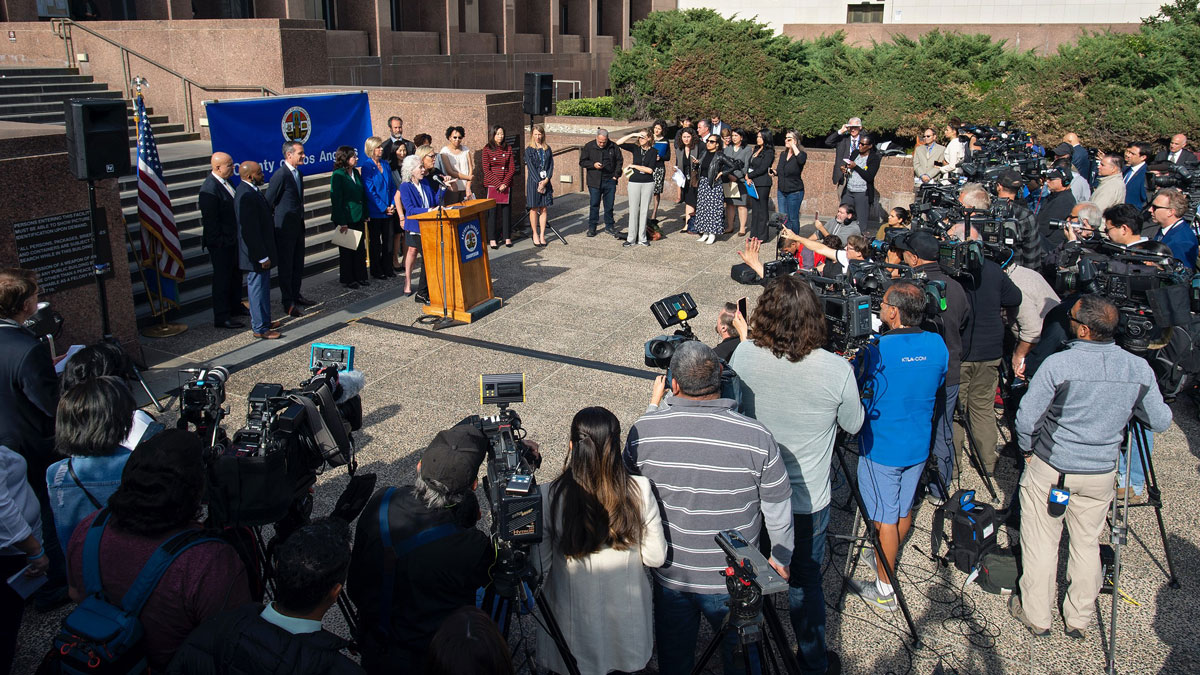
The morning after voters flock to the polls on Super Tuesday, L.A. County public health officials declare an emergency.
The coronavirus is spreading, but residents are assured that a pandemic response is in place. It has been 38 days since L.A. County saw its first reported case, Jan. 26, when a traveler returned from Wuhan, China, to Los Angeles.
L.A. Mayor Eric Garcetti praises local leaders. “In so many places where many jurisdictions are divided, we are so united,” he says. The state of emergency declaration is the “most powerful tool we have at our disposal,” he says.
Barbara Ferrer, the county’s public health director, says the county has “plenty of capacity” for testing, no shortages of test kits and a sophisticated lab.
No serious restrictions are announced: Residents are only advised to wash their hands, stay home when they’re sick and to try to keep six feet from strangers.
Later that same day, Gov. Gavin Newsom issues a state of emergency for California. More than 9,400 Californians with possible travel-related exposure are instructed to isolate themselves at home.
Life, for the most part, continues as normal.
The NBA season heads toward the playoffs. The L.A. Marathon takes place as scheduled, just four days after the emergency declaration. One spectator holds a sign reading, “Run like someone with the coronavirus is behind you!” as bystanders laugh off the threat.
This is our last window of normal, a vacation no one knows they are on.
Widespread closures begin
- L.A. Mayor Eric Garcetti
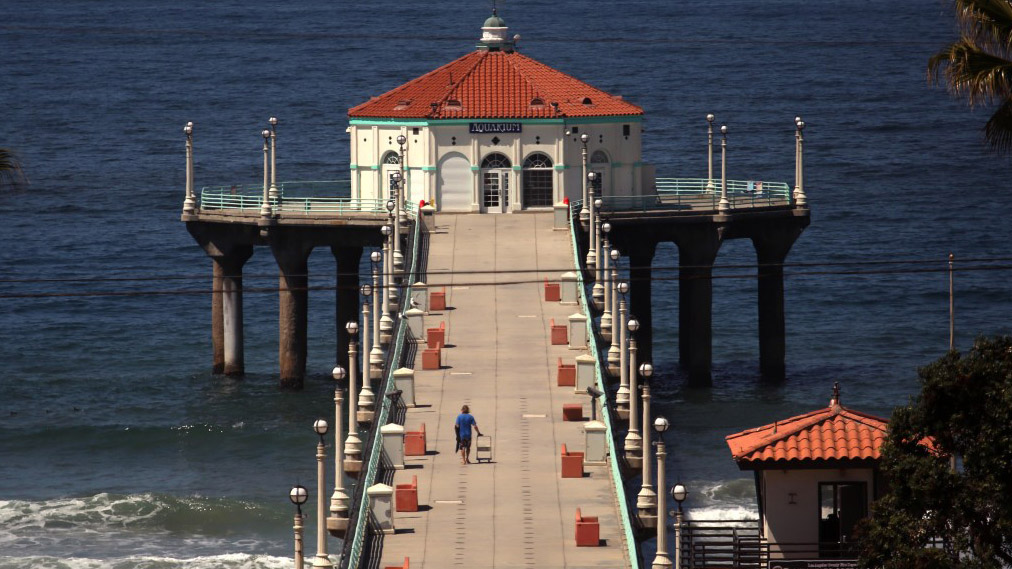
Newsom asks bars and nightclubs to close and residents 65 and older and people with underlying conditions to stay home.
Los Angeles officials go even further. Mayor Garcetti orders bars and nightclubs will close, along with movie theaters, gyms and fitness centers. The L.A. Unified School District closes all of its schools the following day.
Anxiety grips the region, with residents clearing shelves at grocery stores in a rush for food, water and toilet paper.
Californians told to stay at home
- L.A. Mayor Eric Garcetti
Newsom issues the stay-at-home order, making California the first state in the country to do so.
“Let's bend the curve together,” Newsom says at a news conference. “Let's not regret, let's not dream of regretting and saying we coulda, woulda, shoulda.”
Los Angeles, again, takes even stronger measures.
In L.A. County, indoor malls, shopping centers, playgrounds and nonessential retail businesses are ordered to close.
The city of Los Angeles bans public gatherings and orders the closure of all nonessential businesses.
On April 7, Garcetti orders residents and workers to wear masks at essential businesses, and also requires them on trails and at golf courses.
Freeways are empty of cars, a sign of a surging unemployment rate.
A roadmap for reopening
- California Gov. Gavin Newsom
A month into the shutdown, L.A. County seems united.
Residents applaud medical workers nightly from their balconies. Towers downtown shine blue in appreciation. Most people wear masks and keep a safe distance from others.
The efforts appear to work: Studies cited by news reports show California has probably reached its peak number of daily cases if social distancing continues at its current levels.
Gov. Newsom outlines a plan for reopening the economy, listing six criteria that counties must meet to begin opening up businesses.
“This is where public health, not politics, must be the guide,” Newsom says.
L.A. County officials are reluctant to provide many details about reopening. Just a few days prior, they said the stay-at-home orders would be extended until at least May 15.
But the economic and political headwinds are growing. L.A. County loses an estimated 1.3 million jobs, according to a survey from USC. President Trump pressures governors to reopen their economies. And anti-mask protests intensify in California and across the country.
Beaches and retail begin to reopen in L.A.
- L.A. County Public Health Director Barbara Ferrer
In early May, the infection rate in L.A. County stabilizes. Leaders remain cautious.
On May 4, Newsom begins implementing moves to rapidly reopen the state, announcing retail stores, including those that sell books, clothing and toys, can reopen at the end of the week for pickup.
For L.A. County to reopen, it must meet Newsom’s criteria. Once county leaders choose to move forward, cities within the county can decide whether they want to follow the county’s lead or keep more stringent restrictions in place. Garcetti makes those decisions for L.A., the biggest of the 88 cities in the county.
In L.A. County, florists and bookstores open for pickup, in addition to most beaches, hiking trails and golf courses.
“We're going to go extraordinarily slow,” said Ferrer, the county’s public health director. “And the reason why is we don't want to be doing this at the expense of people's lives.”
Disagreement over reopening
- L.A. County Public Health Director Barbara Ferrer
Ferrer incites backlash on May 12 after she tells L.A. County supervisors that the county’s stay-at-home orders will “with all certainty” be extended for the next three months.
California is averaging about 500 deaths and none of Ferrer’s requirements to reopen sooner — at-home testing and an effective COVID-19 treatment — are within sight.
“Recovery will be months long, based on the tools that we have at hand today,” Ferrer says.
She quickly backtracks, however, after the supervisors and Garcetti are inundated with calls.
The following day Ferrer apologizes for inadvertently creating confusion “when I indicated we would need to continue with the health officer orders through the next few months.” She acknowledges there is no end date for when all restrictions will be lifted.
Garcetti, later that same day, tries to soften Ferrer’s initial message: “No, we will not be shut down for three more months. That's not what I heard. That's not what I expect. That's not what I hope.”
L.A. says it won't reopen until July 4
- L.A. County Supervisor Kathryn Barger
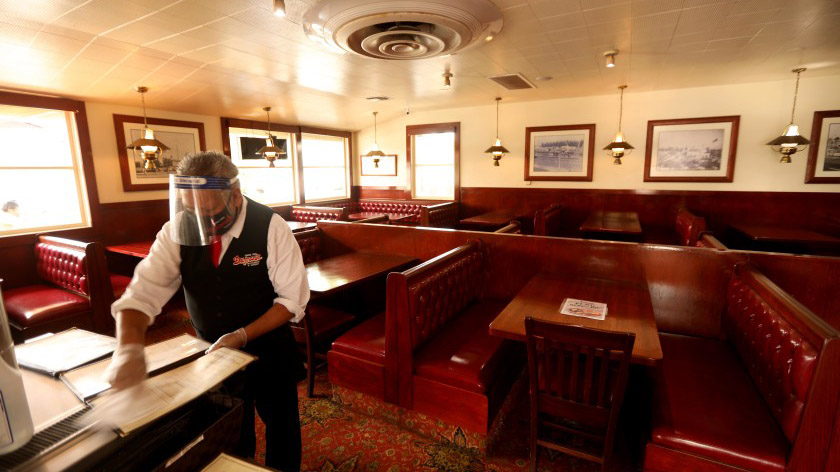
As hospitalizations begin to flatten and testing ramps up statewide, Newsom on May 18 loosens criteria to allow counties that have met his reopening criteria to immediately resume indoor dining in restaurants and reopen shopping malls. Most significantly, he eliminates a requirement that counties would have to log zero deaths from COVID-19 for two weeks to move forward — something that would have been nearly impossible for L.A. County to achieve.
But L.A. leaders warn of moving too quickly and instead offer a July 4 target date for reopening of restaurants and other businesses. Coronavirus transmission remains stubbornly high and the county's death toll surpasses 2,000, more than half of all death’s statewide thus far.
“We are going to really aim together to get there as quickly as possible, but we’re going to pay attention to the data,” Ferrer says. “It’s going to take all of us working together to be able to do this quicker rather than slower.”
Cases drop and L.A. sprints forward with reopening
- L.A. Mayor Eric Garcetti
Five days later, L.A. County leaders abandon their plan to reopen slowly. For weeks, officials have said reopenings would not come all at once but would be a measured, deliberate process.
But the pressure to reopen builds. Across L.A. County, various Chamber of Commerce groups rally businesses, especially in the Antelope, Conejo and Santa Clarita valleys and beach cities, pleading with the L.A. County Board of Supervisors to reopen the economy.
Local leaders, primarily Garcetti and the Board of Supervisors, have long said L.A. County likely won’t reopen as quickly as Orange, Ventura and other surrounding counties because it is the largest and most diverse. But, as every county around L.A. starts to reopen, they forgo this idea and start talking about the importance of the region moving at the same speed.
In the last week of May, L.A. County officials open the following places after updating the county’s health order to match the state and receiving permission from Newsom: restaurants for indoor dining, barbershops and hair salons, places of worship, in-store shopping at retail stores and malls, drive-in movie theaters and flea markets.
Massive protests erupt
- L.A. County Public Health Director Barbara Ferrer
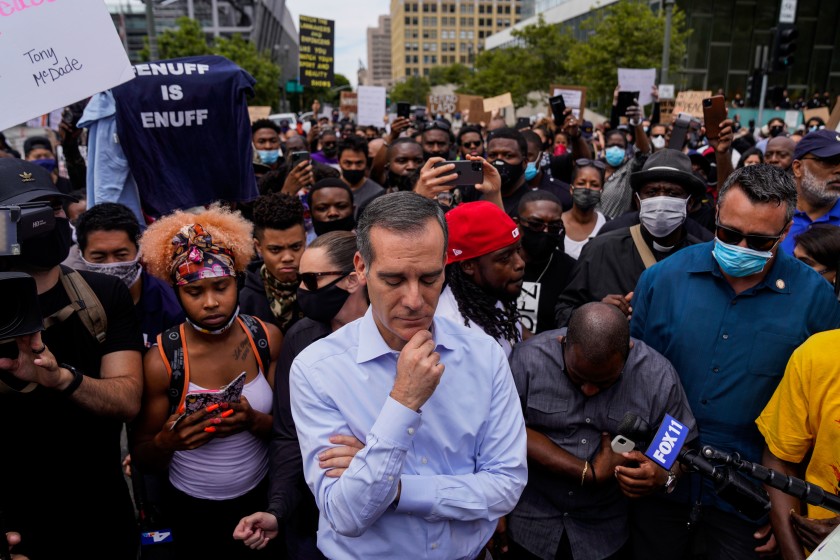
On the same week that L.A. County reopens restaurants and hair salons, major protests break out. The demonstrations against police brutality, which begin May 27 and last more than a week, draw thousands of people.
Health officials worry that close contact among protesters not wearing masks could spread the virus. But it remains unclear how much the protests contributed to a surge in coronavirus cases in L.A. County that began in June. Officials later say the protests likely spread the coronavirus, but are not the main driver of the increase in cases.
At the very least, the protests, along with the reopenings, contribute to mixed messaging about what exactly is safe for people to do. After days of people protesting in the streets, and restaurants and stores welcoming customers inside their doors, Ferrer’s answer to a question about whether family gatherings are allowed surprises and confuses many.
"We are completely not out of the woods,” Ferrer says. “We are in the middle of the woods and we still have a lot of risk. This is not a time for parties or gatherings at your house. We do need you to just remain with the members of your household. ...The only exceptions to that are political protests."
Cases increase, but so do reopenings
- L.A. County Supervisor Kathryn Barger
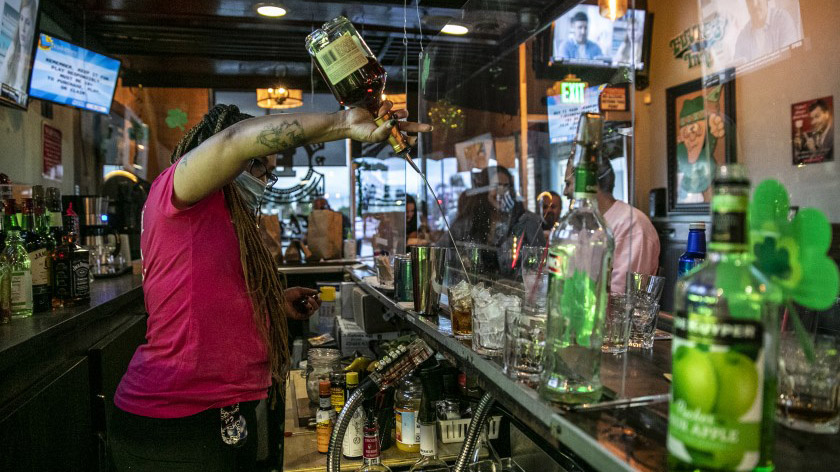
The momentum builds for reopening and, by mid-June, the county allows gyms, bars, wineries and nail salons to unlock their doors and welcome customers.
L.A. County officials at around the same time warn that transmission of the coronavirus and hospitalizations are increasing. For the first time, more than 2,000 new coronavirus cases are reported in a single day. Officials predict that the county could run out of intensive care unit beds in the coming weeks.
Yet, officials maintain that the increases are expected due to the recently eased restrictions, and not necessarily a reason to slow down.
In an interview on June 17, two days before bars reopened, Garcetti says he worries the county is moving too fast. He would have preferred to wait at least three weeks between each step, he says. But the mayor decides to follow the county’s lead, saying that keeping the city closed would do little if the rest of the region was open.
“I’m very nervous about how quickly it’s cascaded ... but I think there’s been immense political pressure,” he said. “We don’t know in three or four weeks where we’ll be and I think we have to be prepared — and we know how to — to be able to walk back. That will be immensely painful.”
Record-breaking rise in cases prompts shutdowns again
- L.A. County Public Health Director Barbara Ferrer
The increases grew even more than officials anticipated. By late June, the county has reported more than 3,000 new coronavirus cases in a single day. Worryingly, the number of people sick enough to be in the hospital approaches never-before-seen highs.
With much of the state experiencing similar surges, Newsom orders closures of bars as well as indoor dining in L.A. and several other counties. Concerned about crowding during the Fourth of July holiday, L.A. County officials also temporarily close beaches.
“I know that everyone is extraordinarily tired, and they're tired of having to deal with this virus. But I also know that this is not forever,” Ferrer says.
Cases in L.A. hit record highs, leading to more reopening rollbacks
- L.A. County Public Health Director Barbara Ferrer
The trends worsen. Newsom implements statewide restrictions that force L.A. County to close gyms, churches, hair salons, malls, zoos and museums.
By July 18, the number of people hospitalized with COVID-19 in L.A. County reaches a high point, with 2,232 patients admitted with the disease. L.A. Unified officials announce they will not reopen campuses for the start of the school year. The Rose Parade is canceled for the first time in 75 years.
"I know this step back in our recovery journey is disheartening, but we must do everything in our power to stop the virus from spreading,” Ferrer says. "We flattened the curve before, and we can do it again.”
More than 5,000 deaths
- L.A. County Public Health Director Barbara Ferrer
The restrictions appear to work. By late July, hospitalizations from COVID-19 begin to plateau, a trend that continues through August. On July 29, officials allow nail salons and hair salons to reopen, but only if they provide all services outdoors.
Still, the experience shows how carefully calibrated the public health response needs to be to keep the public safe while reopening. Despite the improvements, L.A. County’s death toll from COVID-19 surpasses 5,000 on Aug. 11.
Garcetti did not answer questions from The Times about whether he thinks it was a mistake to reopen. His spokesman, Alex Comisar, said in a statement that Garcetti’s responses to “COVID-19 are based on data and the advice of public health experts — never politics.”
“The mayor has made — and will always make — his decisions in the best interests of Angelenos,” Comisar said.
Supervisor Barger said L.A. County reopened businesses with safety precautions in place and pointed to the protests following George Floyd’s death in May as a reason for a massive uptick in cases.
At the same time, she acknowledged one mistake.
“We should have better communicated that the virus was still present in the community,” Barger said. “Many residents and businesses did not heed health officer orders or guidance to continuously wear face coverings, maintain physical distancing and refrain from interacting with people outside of their own household.”
Both Barger and Ferrer stressed the difficulty of responding in real time to a novel virus. Ferrer said in a statement to The Times that “we must be prepared for more unforeseen changes on the road ahead of us.”
Ferrer declined to directly answer questions from The Times about whether she was comfortable with the speed that the county reopened, and what type of pressure, if any, she had faced from elected officials.
“That’s not contradictory — it’s a matter of flexibility as we balance and adapt to the situations we are encountering in real time,” she said.